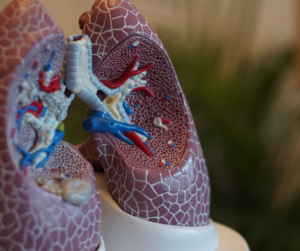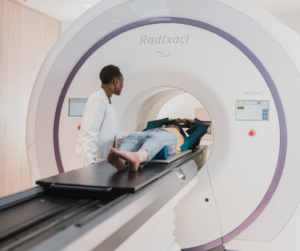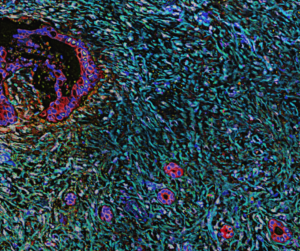Samantha Musson, PharmD & Moe Schwartz, PharmD, BCOP
The term “targeted therapy” in cancer refers to drugs or treatment strategies that direct anticancer treatment to specific genes or proteins that influence the growth, proliferation and/or survival of cancer cells. Antibody-drug conjugates (ADC) are a targeted strategy that has rapidly evolved in cancer care over the last decade. ADC are monoclonal antibodies that are linked to cytotoxic agents; it is a strategy used to exploit the specificity of a monoclonal antibody (mAb) to target a cancer and, ultimately, deliver a cytotoxic drug to that cancer cell. ADCs are drug products that incorporate mAbs and cytotoxic drugs in a single molecular entity, with a nonproprietary name that includes both the name of the mAb and the cytotoxic drug. For example, the ADC discussed in this newsletter belantamab mafodotin-blmf includes the mAb belantamab linked to the microtubule disrupting cytotoxic agent mafodotin, and a four letter suffix given to biologics.
The rationale of ADC therapy in cancer is to deliver a highly effective cytotoxic drug product to cancer cells at a high enough concentration to optimize cell kill and to minimize the exposure of that toxic drug to other cells. As new ADCs come to market, it is helpful to consider both the ADC product and the target of the ADC. The ADC product includes (1) the monoclonal antibody, (2) the cytotoxic agent that is conjugated to the monoclonal antibody and the (3) linker molecule that conjugates the two parts of the drug together. Each of these essential aspects of ADC therapy is briefly described.
Target Selection:
The clinical success of an ADC is due, in part, to the selection of an appropriate target antigen for the mAb. Ideally, the target antigens would be highly expressed in the cancer, and there would be little or no expression in non-cancer cells. If the target antigen is highly expressed in non-cancer cells there is a risk of off-target ADC uptake, and the toxicities that are seen with less targeted anticancer approaches. Additionally, an ideal target for an ADC should be readily accessible to the ADC after administration; therefore the targets of ADC are often tumor-associated antigens localized on the cell surface.
Monoclonal Antibody:
The mAb in an ADC is developed to optimize binding to the antigen on the target cancer cell and facilitate concentration of the cytotoxic drug in the cell. Optimally, the mAb binds selectively to the cancer cells and has limited cross-reactivity with non-cancer cells. There has been significant advancement in the development of mAbs for cancer, including refining the structure of a therapeutic antibody to illicit a better antitumor response, and these advancements may impact the success of ADC therapy.
Cytotoxic Payload:
The cytotoxic drug component, sometimes referred to as the payload, of an ADC is a critical factor of the drug’s efficacy. These cytotoxic drug components are highly toxic compared with even standard chemotherapeutic agents, and include mechanisms such as DNA-damaging agents and microtubule toxins. As these drugs are cytotoxic, they should be handled with the same care as chemotherapy.
Linker:
The linker section of an ADC connects the cytotoxic drug to the mAb. The linker must allow the release of the cytotoxic drug in its active form within or close to the target cancer cell. Premature release of cytotoxic drug from the mAb can increase systemic toxicity and decrease efficacy. Currently marketed ADCs attach mAbs to cytotoxic agents with either cleavable or noncleavable linkers. Cleavable linkers release the cytotoxic drug from the mAb due to the difference in condition (e.g., pH) within the cell compared to the bloodstream. Noncleavable linkers release the drug after the ADC had been internalized within the cell.
The Evolving Applications of ADC in Cancer Care:
A number of ADCs are now routinely used in the treatment of a variety of cancers and are listed in Table 1. The target of the mAb of the ADC is also included, and provide some suggestion for future applications for the drug beyond current labeling. For example, sacituzumab govitecan-hziy is an ADC consisting of a humanized antibody that targets Trop-2 that is linked to a small molecule topoisomerase inhibitor. Trop-2 is a cell surface glycoprotein that has a role in intracellular signaling and in epithelial-mesenchymal transition, overexpression of Trop-2 may be an important target in a variety of cancers. Of note, Trop-2 is often overexpressed in metastatic breast cancer. Sacituzumab govitecan-hziy binds to Trop-2-expressing cancer cells and is internalized, releasing the cytotoxic molecule. The topoisomerase inhibition causes DNA strand breaks, apoptosis and cell death. At the time of marketing in April 2020, sacituzumab govitecan-hziy was indicated for the treatment of adults with locally advanced or metastatic triple-negative breast cancer who had received at least two prior therapies for metastatic disease. Less than a year later, the FDA granted accelerated approval to sacituzumab govitecan to treat patients with locally advanced or metastatic urothelial carcinoma after having received either a PD-1 or PD-L1 inhibitor and a platinum-based chemotherapy.
There are a number of ADCs currently in clinical trials, many with unique targets. The potential role of marketed products continue to evolve. (Abdollahpour-Alitappeh M, 2019)
| Antibody Drug Conjugates Approved in the United States | ||||
| Non-Proprietary Name | Brand Name | Target Antigen | Drug Conjugate | FDA Approved Clinical Indications exist in the listed diseases * |
| Ado-trastuzumab emtansine | Kadcyla | HER2 | Microtubule inhibitor DM1 | Breast Cancer |
| Belantamab mafodotin-blmf | Blenrep | B-cell maturation antigen (BCMA) | Microtubule disrupting agent: monomethylauristatin F (MMAF) | Multiple myeloma |
| Brentuximab vedotin | Adcetris | CD30 | Microtubule disrupting agent: monomethylauristatin E (MMAE) | Anaplastic Large Cell Lymphoma CD30 expressing T cell lymphoma Hodgkin Lymphoma |
| Enfortumab vedotin-eifv | Padcev | Nectin-4 | Microtubule disrupting agent: monomethylauristatin E (MMAE) | Urothelial Cancer |
| Fam-Trastuzumab deruxtecan-nxki | Enhertu | HER2 | Topoisomerase inhibitor DXd | HER2+ Breast Cancer HER 2+ Gastric Adenocarcinoma HER2+ gastroesophageal adenocarcinoma |
| Gemtuzumab ozogamicin | Mylotarg | CD33 | Calicheamicin derivative | CD33+ Acute myeloid leukemia |
| Inotuzumab ozogamicin | Besponsa | CD22 | Calicheamicin derivative | B-cell precursor acute lymphoblastic leukemia |
| Loncastuximab tesirine-lpyl | Zynlonta | CD19 | Pyrrolobenzodiazepine dimer cytotoxic alkylating agent | Diffuse large B-cell lymphoma |
| Polatuzumab vedotin-piiq | Polivy | CD79b | Microtubule disrupting agent: monomethylauristatin E (MMAE) | Diffuse Large B-Cell Lymphoma |
| Sacituzumab govitecan-hziy | Trodelvy | TROP-2 | Topoisomerase 1 inhibitor: SN-38 (govitecan) | Triple Negative Breast Cancer Urothelial cancer |
*refer to package labeling for specific indications criteria.
Samantha Musson, PharmD & Moe Schwartz, PharmD, BCOP | Jun 8, 2021 2:46:44 PM
References:
Abdollahpour-Alitappeh M, Lotfinia M, Gharibi T, et al. Antibody-drug conjugates (ADC) for cancer therapy: Strategies, challenges and successes. J Cel Physiol 2019;234: 5628-5642.
Joubert N, Beck A, Dumontet C, Denevault-Sabourin C. Antibody-Drug Conjugates: The Last Decade. Pharmaceuticals (Basel). 2020;13(9):245. Published 2020 Sep 14. doi:10.3390/ph13090245
Hafeez U, Parakh S, Gan HK, Scott AM. Antibody-Drug Conjugates for cancer therapy. Molecules. 2020; 25(20):4764.
Seligson JM, Patron AM, Berger MJ, Harvey RD, Seligson ND. Sacituzumab govitecan-hziy: an antibody-drug conjugate for the treatment of refractory, metastatic, triple-negative breast cancer. Annals Pharmaco 2021; 55(7):921-931.

Samantha Musson, PharmD
Pharmacy Resident, Mercy Health – Fairfield Hospital, Fairfield, OH

Moe Schwartz, PharmD, BCOP
University of Cincinnati, Cincinnati, OH







